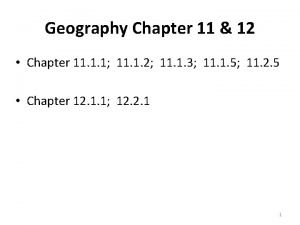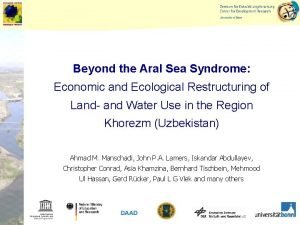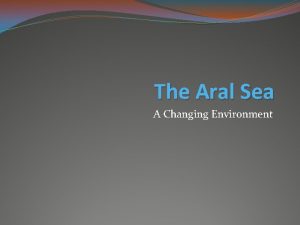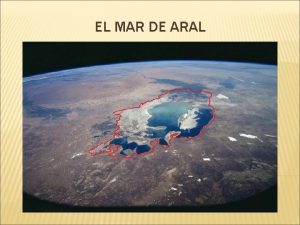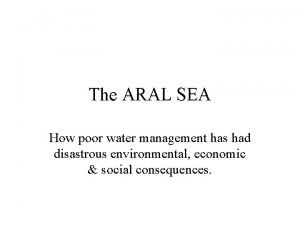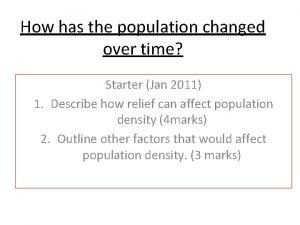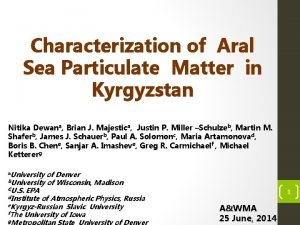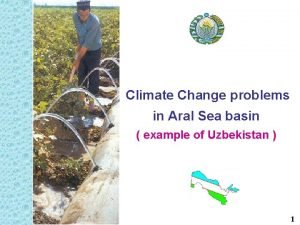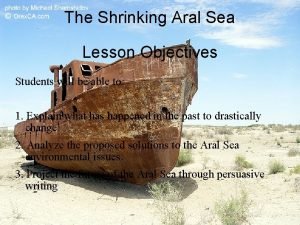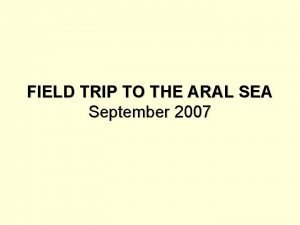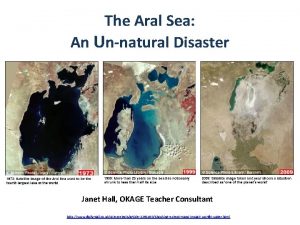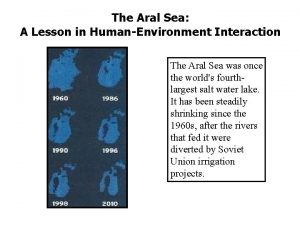How Has the Aral Sea Changed Over Time














- Slides: 14

How Has the Aral Sea Changed Over Time? Sally Student, Sam Student Circle High School, Mrs. Teacher, grades 6 to 8

The Situation As shown in these satellite images, the Aral Sea dramatically changed in size from August 2000 through August 2010.

About the Aral Sea The Aral Sea in central Asia is drying up. Rivers that once flowed into the lake have been diverted to irrigate crops. Fresh water has evaporated, increasing the salinity of the water and killing many fish. The Aral Sea is located in Central Asia, between Kazakhstan & Uzbekistan. Image credit: World Bank http: //web. worldbank. org/WBSITE/EXTERNAL/COUN TRIES/ECAEXT/0, , content. MDK: 20634287~page. PK: 1 46736~pi. PK: 146830~the. Site. PK: 258599, 00. html

This photo shows abandoned boats in the now dry parts of the Aral Sea. Photo Credit: Paul Thomas, 2008, Trek earth (http: //www. trekearth. com/gallery/Asia/Uzbekistan/West/Nukus/Moynaq/photo 9 03696. htm)

Problem & Prediction Research Question: How has the Aral Sea changed over time? Prediction: We think that the loss of water in the Aral Sea has occurred at a steady, linear rate through time and that it could dry up completely within 10 years.

Methods We used Image. J to analyze NASA MODIS satellite images from the World of Change collection at the NASA Earth Observatory ◦ http: //earthobservatory. nasa. gov/Features/World. Of. Change/aral_s ea. php We also read NASA Earth Observatory Articles: ◦ ◦ http: //earthobservatory. nasa. gov/IOTD/view. php? id=1396 http: //earthobservatory. nasa. gov/IOTD/view. php? id=2057 http: //earthobservatory. nasa. gov/IOTD/view. php? id=3322 http: //earthobservatory. nasa. gov/IOTD/view. php? id=3730

Data Analysis Steps 1. 2. 3. 4. 5. 6. Import all eleven images into Image. J to create a stack Animate the stack to observe the change in the area of the lake through time. Make the year 2000 image active and use it to set a scale in Image. J. Propagate the scale to the remaining images. Starting with the 2000 image, use the straight line selection tool to measure the distance across the lake at two recognizable points. Repeat for the other 10 images (2001 through 2010). Measuring the distance across the Aral Sea using the straight line selection tool in Image. J for August 2000 satellite image.

Data Analysis Steps 7. 8. 9. 10. Use the free hand selection tool to measure the area of the lake in each image. Save and open results into Excel. Graph results with measurements on the y-axis and years on the xaxis. Create two graphs, one showing the change in distance across the lake through time and the other showing the change in area of the lake through time. Calculate the average annual rate of change in the width and the area of the Aral Sea from 1960 to 2009.

Results for Distance In 1960, the width across the Aral Sea was 235. 625 km. By 2009, that width was reduced to 20 kilometers. Between 1960 and 2009, the Aral Sea shrunk at a rate of approximately 4. 3 kilometers in width per year.

Results for Area The area of the Aral Sea was 66, 784. 3 kilometers squared in 1960, but only 4049. 74 kilometers squared by 2009. Between 1960 and 2009, the Aral Sea shrunk at a rate of approximately 1, 255 kilometers squared in area per year. .

Findings & Discussion In 1960, the width across the Aral Sea was 235. 625 km. By 2009, that width was reduced to 20 kilometers. In a similar manner, the area of the Aral Sea was 66, 784. 3 kilometers squared in 1960, but only 4049. 74 kilometers squared by 2009. We took the difference between the 2009 widths and areas and the 1960 measurements, dividing this difference by the number of years (50) to calculate average yearly rates of change. Between 1960 and 2009, the Aral Sea shrunk at a rate of approximately 4. 3 kilometers in width per year and at a rate of approximately 1, 255 kilometers squared in area per year.

Conclusions Based upon the data we collected and the graphs we produced, Aral Sea is shrinking at a steady rate through time. However, because we are missing data from the years 1961 through 1999, it is not possible to characterize the loss as either a linear or exponential rate. At our calculated rate of change (1255 squared kilometers loss in area per year), the Aral Sea could be dry in as few as 3. 2 years. These results support our initial hypothesis that the Aral Sea could be dry within 10 years.

Limitations to Our Research Through the years, the distance loss across the left side of the lake is less than on the right side, perhaps because the left side of the lake is deeper. Changes in the volume of a threedimensional shape such as a lake cannot be characterized very accurately by measuring only one dimension, such as width or area. Our projections are based on the assumption that the lake will continue to lose water in future years. In fact, in 2010, both the width and the area of the Aral Sea increased. We measured the width and came up with 126 kilometers. The area was 9437 kilometers squared. If steps are taken to replenish the water, then the sea might not dry up after all.

Implications for the Future Through If the Aral Sea continues to shrink, it is in danger of completely drying out. Further loss of the Aral Sea could have significant negative impacts on agriculture and human health in surrounding communities and beyond as sand full of salts, minerals, and toxins gets swept away from the dried up lake bed. This environmental situation is not limited to the Aral Sea. We need to monitor our lakes to ensure an adequate supply of water for the future.
 Aral sea changed over time
Aral sea changed over time The western siberian plain __________.
The western siberian plain __________. How have attitudes towards immigrants changed over time
How have attitudes towards immigrants changed over time How computers have changed over time
How computers have changed over time Aral sea syndrome
Aral sea syndrome What does the picture depict
What does the picture depict Setting of metamorphosis
Setting of metamorphosis Macbeth act two scene two
Macbeth act two scene two How has technology changed sports
How has technology changed sports Dave grolsh
Dave grolsh Has the exchange rate changed chapter 10
Has the exchange rate changed chapter 10 Has the exchange rate changed chapter 10
Has the exchange rate changed chapter 10 Aegean sea troy
Aegean sea troy What is asias largest desert
What is asias largest desert Hydra coral
Hydra coral

